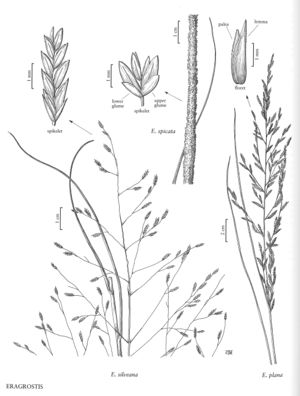Difference between revisions of "Eragrostis plana"
FNA>Volume Importer |
imported>Volume Importer |
||
| (2 intermediate revisions by the same user not shown) | |||
| Line 38: | Line 38: | ||
|publication year= | |publication year= | ||
|special status= | |special status= | ||
| − | |source xml=https:// | + | |source xml=https://bitbucket.org/aafc-mbb/fna-data-curation/src/200273ad09963decb8fc72550212de541d86569d/coarse_grained_fna_xml/V25/V25_148.xml |
|subfamily=Poaceae subfam. Chloridoideae | |subfamily=Poaceae subfam. Chloridoideae | ||
|tribe=Poaceae tribe Cynodonteae | |tribe=Poaceae tribe Cynodonteae | ||
Latest revision as of 17:57, 11 May 2021
Plants perennial; cespitose, with innovations, without rhizomes. Culms 65-100 cm, erect, glabrous. Sheaths flattened, smooth, shiny, glabrous or puberulent; ligules 0.2-0.4 mm; blades 15-50(70) cm long, 2-4 mm wide, folded, margins involute or revolute, abaxial surfaces glabrous or sparsely hairy, adaxial surfaces scabridulous. Panicles 13-28 cm long, 2-8 cm wide, narrowly oblong to narrowly lanceolate, contracted to open; primary branches 1-8 cm, appressed or diverging up to 30° from the rachises; pulvini glabrous or hairy; pedicels 1-7 mm, appressed, glabrous. Spikelets 6-14 mm long, 1.3-2.5 mm wide, linear-oblong, greenish to plumbeous, with 9-14 florets; disarticulation acropetal, paleas persistent. Glumes narrowly ovate to lanceolate, membranous to hyaline; lower glumes 0.4-1.2 mm, scalelike; upper glumes 1-1.5 mm; lemmas 1.8-3 mm, ovate, membranous, strongly keeled, keels with minute punctate glands, lateral veins conspicuous, apices acute to obtuse; paleas 1.8-3 mm, hyaline to membranous, bases not projecting beyond the lemmas, apices obtuse to truncate; anthers 3, 1.2-1.8 mm, reddish-purple. Caryopses 1-1.6 mm, rectangular-prismatic to ovoid, laterally compressed, adaxial surfaces deeply grooved, smooth, opaque, reddish-brown. 2n = 20.
Discussion
Eragrostis plana is native to southern Africa. It is known from two locations in the Flora region, both waste areas near sheep and cattle lots in Florence County, South Carolina.
Selected References
None.
